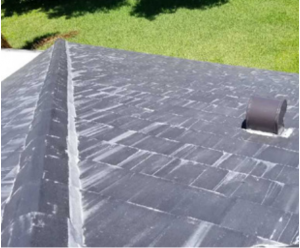With recent reports of surface efflorescence stemming from hip and ridge mortar on tile roofs, the Tile Roofing Industry Alliance (TRIA), a non-profit association of producers and associates of concrete and clay tile, has published a Technical Brief to address the common occurrence.
 The use of mortar for the attachment and weather blocking of hip and ridge tiles is a code approved option for tile installations. When mortar is used as a component, either for fastening or weather blocking, there is the opportunity for hip and ridge mortar generated efflorescence to occur on the surface of the underlying roof tiles. The amount of mortar, water content and weather conditions can impact the amount of efflorescence that might occur.
The use of mortar for the attachment and weather blocking of hip and ridge tiles is a code approved option for tile installations. When mortar is used as a component, either for fastening or weather blocking, there is the opportunity for hip and ridge mortar generated efflorescence to occur on the surface of the underlying roof tiles. The amount of mortar, water content and weather conditions can impact the amount of efflorescence that might occur.
Efflorescence is a temporary surface discoloration common to all concrete based building materials including mortar and concrete roof tiles. It is superficial and in no way detrimental to the overall quality, structural integrity, or functional properties of the tile.
Efflorescence is caused by the chemical nature of the cement. Manufactured cement contains free lime, and when water is added, a series of chemical reactions take place. These reactions are accompanied by the release of calcium hydroxide, which can form an overall “white chalky” crystalline salt deposit on the tile surface when reacting with carbon dioxide. This reaction can appear as an overall “bloom” (overall softening of color) or in more concentrated patches.
It is difficult to predict how long the effects of efflorescence will last. It depends on the type and amount of deposit as well as the local weather conditions. In most cases the action of carbon dioxide and rainwater will gradually remove the deposit.
The manufacturer of the mortar materials may help provide additional methods for reducing, sealing or cleaning efflorescence created by their products.
As aforementioned, efflorescence is superficial and in no way affects the quality, functional properties, or the structural integrity of the concrete roof tile. Your roof will continue to be energy efficient, visually stunning and durable, withstanding the elements of rain, snow, high wind and scorching heat for the life of your structure. Simply allow the natural reaction to run its course and within time, rain water and carbon dioxide will wash away the chalky residue and the original color of the tile will reappear without further efflorescence occurring.
If you have any questions or concerns regarding your concrete tile roof, please contact your local Eagle Account Representative.
